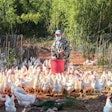
A computer vision system that uses artificial intelligence (AI) could help producers detect bumblefoot in cage-free environments, according to research from the University of Georgia (UGA).
The system uses cameras, strategically placed, throughout a house that capture bird movement and behavior. The AI technology uses a deep learning model to analyze the film and detect the presence of bumblefoot.
The technology was found to be 86% accurate in detecting cases of bumblefoot, however, because it is still in development, there were limitations to the research.
The limitations
According to the UGA researchers, stocking density affects detection, especially when birds are densely packed together, because neighboring hens can inhibit the bird movement needed to detect bumblefoot. Also, because bumblefoot can start as mild, it can be difficult to detect when a hen is far from the camera.
Environmental factors, such as higher dust concentrations typically seen in cage-free housing, were found to affect the camera’s accuracy. The presence of manure on litter floors can mask bumblefoot symptoms or falsely enlarge foot sizes, which reduced detection accuracy.
Furthermore, the study used fewer hens per room compared to commercial housing, which could cause issues when scaling up the system for larger flocks.
The researchers indicated that testing, data collection and model training would continue to enhance detection accuracy and address the limitations.
More about bumblefoot
In cage-free systems, bumblefoot is mainly observed in layers reared on litter floors.
Bumblefoot, also known as pododermatitis, is a bacterial infection or abscess that affects a chicken's foot pad. It can be caused by cuts, scratches, punctures, bruises or other injuries to the foot that become contaminated.
It can be challenging to detect hens with bumblefoot, and it could become a greater issue in the U.S. as producers are converting their production to include more cage-free systems, according to the UGA researchers. Currently, no automatic detection methods are available to help poultry producers identify the infection.



















